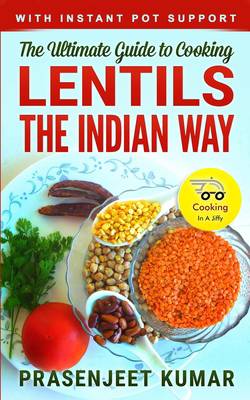
- Afhalen na 1 uur in een winkel met voorraad
- Gratis thuislevering in België vanaf € 30
- Ruim aanbod met 7 miljoen producten
- Afhalen na 1 uur in een winkel met voorraad
- Gratis thuislevering in België vanaf € 30
- Ruim aanbod met 7 miljoen producten
The Ultimate Guide to Cooking Lentils the Indian Way
Prasenjeet KumarOmschrijving
We all know that as the cheapest and most versatile proteins available to mankind, legumes and lentils have been cultivated and consumed from time immemorial.
Lentils are mentioned in religious books such as the Bible, Quran, and the Vedas.
˃˃˃ Lentils were so important for those long sea voyages that the Romans named their emperors after the most common legumes: Lentulus (lentil), Fabius (fava), Piso (pea), and Cicero (chickpea).And yet, legumes and lentils came to be almost forgotten in the modern post-20th century world with easy availability of red meat and the rise of fast food joints.
Now thanks to scientists and expert bodies like the Mayo Clinic, we know that legumes and lentils are actually better than meat.
˃˃˃ Legumes and Lentils are the "Healthiest Food" in the World.Legumes and lentils are good for a Healthy Heart: These contain significant amount of folate and magnesium, both doing wonders for your heart.
Legumes and lentils replenish Iron Needed for Energy: These are rich in Iron, which is a vital component of energy production and metabolism in the body.
Legumes and lentils are low in cholesterol: These, unlike red meat, are low in fat, calories, and cholesterol. They are also somewhat lower in oxalic acid and similar chemicals which cause stone formation in kidneys and result in gout, a painful affliction of joints caused by the deposition of oxalate crystals.
Legumes and lentils are rich in fiber: If you are looking for ways to reduce constipation, try legumes and lentils as they contain a high amount of dietary fiber, both soluble and insoluble.
˃˃˃ The way Indians cook legumes and lentils is unmatched by any other cuisine on Planet Earth.This is because almost every Indian meal has to have a legume and lentil dish, as dal (soup), curry, snack, or dessert. So, they have centuries of expertise in turning legumes and lentils in whichever way you want.
On the other hand, most western cook books would, at the most, recommend baking legumes and lentils with cheese, putting them in hamburgers, having them with sausages and casseroles, or making lentils stew.
One is, of course, not counting the lentils sprouts salad or the famous students' dorm dish of baked beans (straight from the can) as well as the West Asian "sauce" hummus, without which no Lebanese meal can be termed complete.
There is nothing wrong if you want to have your legumes and lentils this way.
˃˃˃ But if you want to experiment, and wish to embark upon a roller coaster culinary adventure, you must look at Indian cuisine."The Ultimate Guide to Cooking Lentils the Indian Way" lets you savor, in this background, as many as twenty most popular "Home Style" dal recipes, ten curries, six dishes cooked with rice, eleven snacks, three kebabs, three stuffed parathas, and five desserts.
˃˃˃ It is said that without carrying Sattu or roasted chickpea flour with them, for sustenance on those long and arduous treks, Buddhist monks from India could NOT have spread Buddhism to such far off places from Afghanistan and Tibet to China, Korea, and Japan!Still don't believe about India's robust lentil tradition?
Then scroll above and buy a copy now! Or download a sample.Specificaties
Betrokkenen
- Auteur(s):
- Uitgeverij:
Inhoud
- Aantal bladzijden:
- 218
- Taal:
- Engels
- Reeks:
- Reeksnummer:
- nr. 4
Eigenschappen
- Productcode (EAN):
- 9798630128171
- Verschijningsdatum:
- 26/03/2020
- Uitvoering:
- Paperback
- Formaat:
- Trade paperback (VS)
- Afmetingen:
- 127 mm x 203 mm
- Gewicht:
- 240 g

Alleen bij Standaard Boekhandel
Beoordelingen
We publiceren alleen reviews die voldoen aan de voorwaarden voor reviews. Bekijk onze voorwaarden voor reviews.











